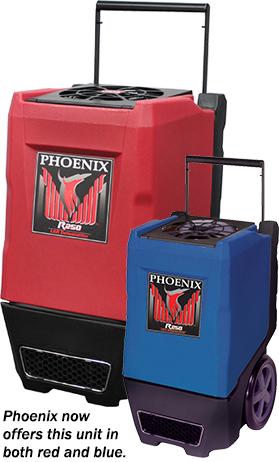Phoenix R250 LGR Dehumidifier
 With a desiccant dehumidifier, water vapor is extracted from the desiccant rotor by exposing a “wet” part of the rotor to a hot air flow. It’s referred to as reactivation and causes water vapor to release from the desiccant material’s surface and seep into the reactivation air flow. Then, this moist, hot air is exhausted from the unit. The heat’s power source for regeneration is electric upon portable desiccants and may be propane, electric, natural gas or occasionally diesel on larger desiccants.
With a desiccant dehumidifier, water vapor is extracted from the desiccant rotor by exposing a “wet” part of the rotor to a hot air flow. It’s referred to as reactivation and causes water vapor to release from the desiccant material’s surface and seep into the reactivation air flow. Then, this moist, hot air is exhausted from the unit. The heat’s power source for regeneration is electric upon portable desiccants and may be propane, electric, natural gas or occasionally diesel on larger desiccants.
A desiccant wheel gradually rotates through a process chamber and reactivation chamber. Air flow of the air streams usually are in opposite directions through the wheel. It usually blows out all airborne debris which might’ve been captured from the process air. Normally, the regeneration air flow is ¼ – ⅔ of process air flow. It’s a continual cycle; process section over to regeneration section. You can load up with moisture within the process section then unload within the regeneration section.
Desiccants that have separated air flows commonly are called 4-hole desiccants. They’re generally designated by process airflow volume, due to that giving an idea of the desiccant’s drying ability. A variation of this design includes the 3–hole desiccant that utilizes one inlet for process and reactivation air then diverts a part of processed air for reactivation. The 3–hole desiccants oftentimes perform better under damp and cool circumstances due to the reactivation air being dried and warmed in the process phase. The drier and warmer the reactivation air source is, the more efficient the desiccant operation will be.
Phoenix R250 LGR Dehumidifier was redesigned to be a high-performance, rugged dehumidifier. Phoenix leads this industry by releasing epoxy-coated coils. The new feature extends the life of the coils, offer protection within corrosive environments, as well as maintain the coil’s heat transfer capability. Also, Phoenix added a heavy-duty condensate pump, as well as a rugged float switch that is specifically designed for restoration environments.
They kept the handle utilized on the R200 in conjunction with their ByPass™ technology, pleated media filter, multiple ducting options, and increased airflow.
To check out our Phoenix R250 LGR Dehumidifier visit our store here.
https://waterdamageequipment.com
